Effective Massage for Muscle Stiffness | Relieve Pain & Improve Flexibility
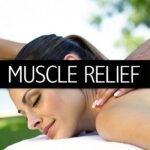
Yes, a massage provides that incredible, instant relief for stiff muscles, but what's happening beneath the surface is more than just a fleeting "feel-good" moment. It's a powerful mechanical process. The pressure from a skilled massage physically pushes out cells that cause inflammation, reduces fluid buildup, and jump-starts healing by improving blood flow right where you need it most.
Why Massage Actually Works for Stiff Muscles
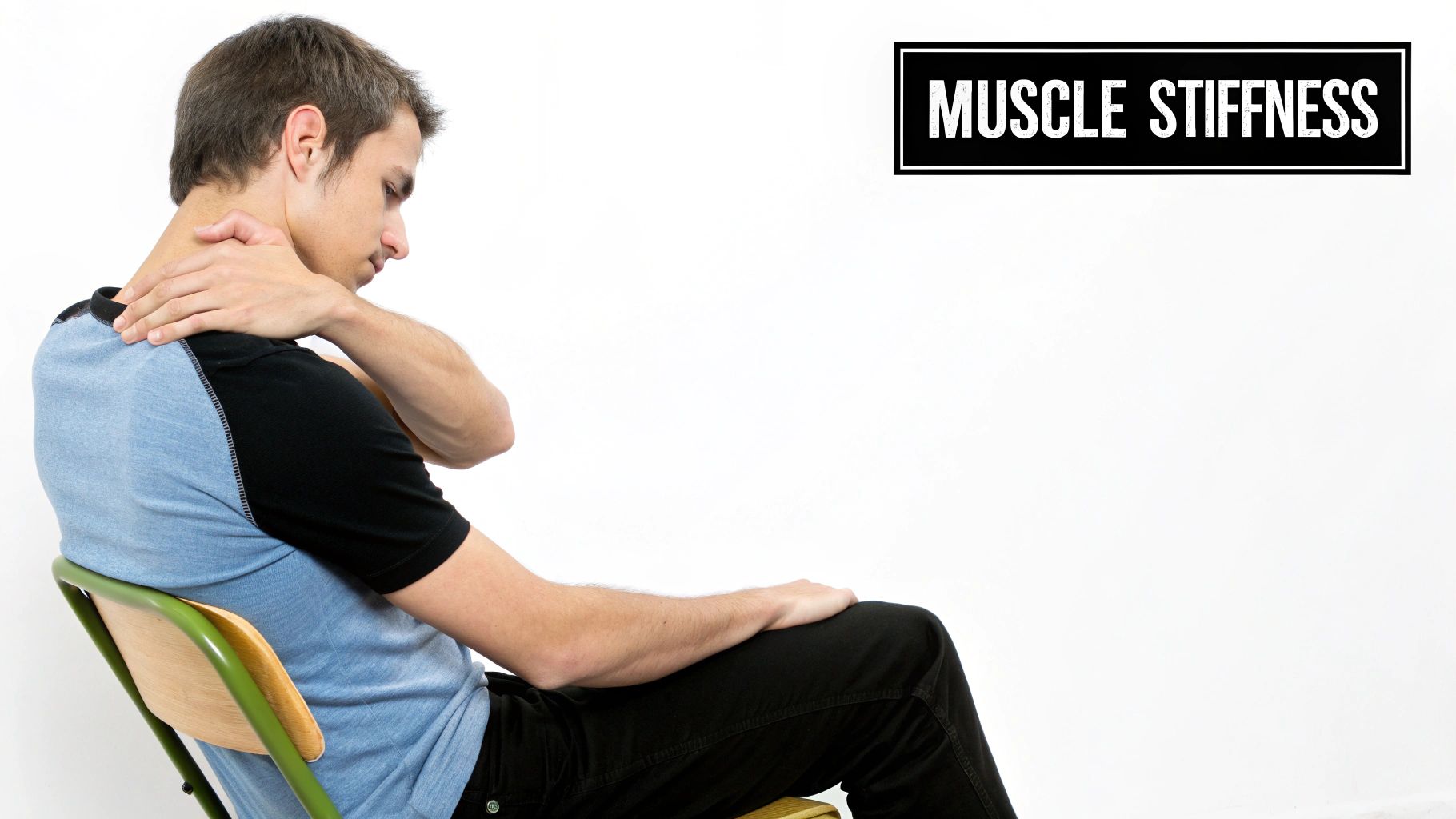
When your muscles are tight and full of knots, it’s usually because of a buildup of metabolic waste and inflammatory responses. This happens after a tough workout, a stressful week, or even just from sitting at a desk all day. Massage acts as a direct, hands-on solution to these biological traffic jams.
I like to think of a stiff muscle as a sponge soaked in murky water. The targeted pressure of a massage literally squeezes that "murky water" out. This isn't just water; it's a mix of inflammatory substances like cytokines and neutrophils that are causing your pain. Once they're cleared, fresh, oxygen-rich blood can soak back into the muscle tissue. This improved circulation is everything—it delivers the nutrients your muscles are crying out for to repair and recover.
This isn't just a nice analogy; it's what's really happening. Research from Harvard Wyss Institute backs this up, showing how mechanical compression, just like a massage, significantly speeds up healing in injured muscles. Researchers found that the pressure physically expelled the inflammatory cells from the muscle tissue, which directly led to faster and stronger muscle fiber regeneration.
How Massage Directly Impacts Stiff Muscles
To really get it, let's break down how massage directly interacts with your muscle tissue to alleviate that stiffness and get you back to feeling good.
| Mechanism | Effect on Muscle Stiffness | Benefit |
|---|---|---|
| Mechanical Pressure | Squeezes out and clears inflammatory cells (like neutrophils) from the muscle. | Reduces the primary source of pain and swelling. |
| Increased Circulation | Brings fresh, oxygenated blood to the muscle fibers. | Delivers vital nutrients needed for repair and recovery. |
| Myofascial Release | Loosens tight muscle fibers ("knots") and the surrounding connective tissue (fascia). | Relieves localized pain and restores ease of movement. |
| Nervous System Response | Signals the brain to relax the muscles, decreasing tension. | Enhances overall relaxation and reduces protective muscle guarding. |
Essentially, the relief you feel is the direct result of these actions working together inside your muscles.
What This Means for You
Understanding these mechanisms helps you see why specific massage techniques feel so effective. It’s not magic; it’s physiology.
- Less Inflammation: By physically clearing out inflammatory agents, massage directly tackles the source of your soreness.
- Better Blood Flow: Think of it as opening up a superhighway for healing nutrients to reach damaged muscle fibers.
- Reduced Muscle Tension: Those painful "knots" are released, immediately easing localized pain and improving how you move.
- Improved Flexibility: When your muscles and the connective tissue around them (the fascia) are loosened, your range of motion naturally increases.
The key thing to remember is that massage is an active treatment. It’s a hands-on intervention that changes the physiological environment within your muscles, creating the perfect conditions for healing and pain relief.
This is a huge deal for athletes and anyone who is physically active. If you’re looking to boost your recovery and performance, knowing this is a game-changer. In fact, our guide on sports massage therapy dives deeper into how specific techniques can make all the difference in your training. By targeting problem areas, you bounce back faster and lower your risk of future injuries.
Practical Self-Massage for Neck and Shoulder Tension
Let’s be honest, that nagging stiffness in your neck and shoulders feels like a constant companion these days. It’s the price we pay for long hours at a desk, stressful commutes, or even just sleeping awkwardly. But you don't have to just put up with it. You’ve got the power to work out those kinks yourself, and it’s easier than you think.
True relief isn't about some complicated, hour-long routine. It's about finding simple, effective ways to target tension the moment you feel it. When that familiar ache starts creeping up your neck at work, you can take action right there at your desk. Just use your hand to gently squeeze and knead the trapezius muscle—that large, meaty muscle connecting your neck and shoulder. It’s an instant release.
Simple Techniques for Immediate Relief
One of my favorite tricks for hitting those stubborn knots uses nothing more than a wall and a tennis or lacrosse ball. Just stand with your back to a wall, pop the ball between it and the tight spot in your shoulder, and bend your knees. This lets you roll the ball right over the tension, applying as much or as little pressure as you need. It’s fantastic for getting into those spots you can’t quite reach on your own.
For the neck itself, here are a couple of go-to moves you can do anywhere:
- The Squeeze & Breathe: Gently pinch the tight muscle on the side of your neck with your thumb and forefinger. Hold it for about 10-15 seconds while you take a deep, slow breath, then let go. Feel the tension melt away with your exhale.
- The Press & Tilt: Place the pads of your fingers on the back of your neck, right where it slopes down to your shoulder. Press firmly into the muscle and, at the same time, slowly tilt your head away from that side. You’ll feel a wonderful, deep stretch.
The real magic here is accessibility. These aren't just exercises; they're practical, real-world solutions. You can do them in a five-minute break between meetings or after a particularly tense phone call to reset your body.
The image below highlights some common reasons we get so stiff in the first place.
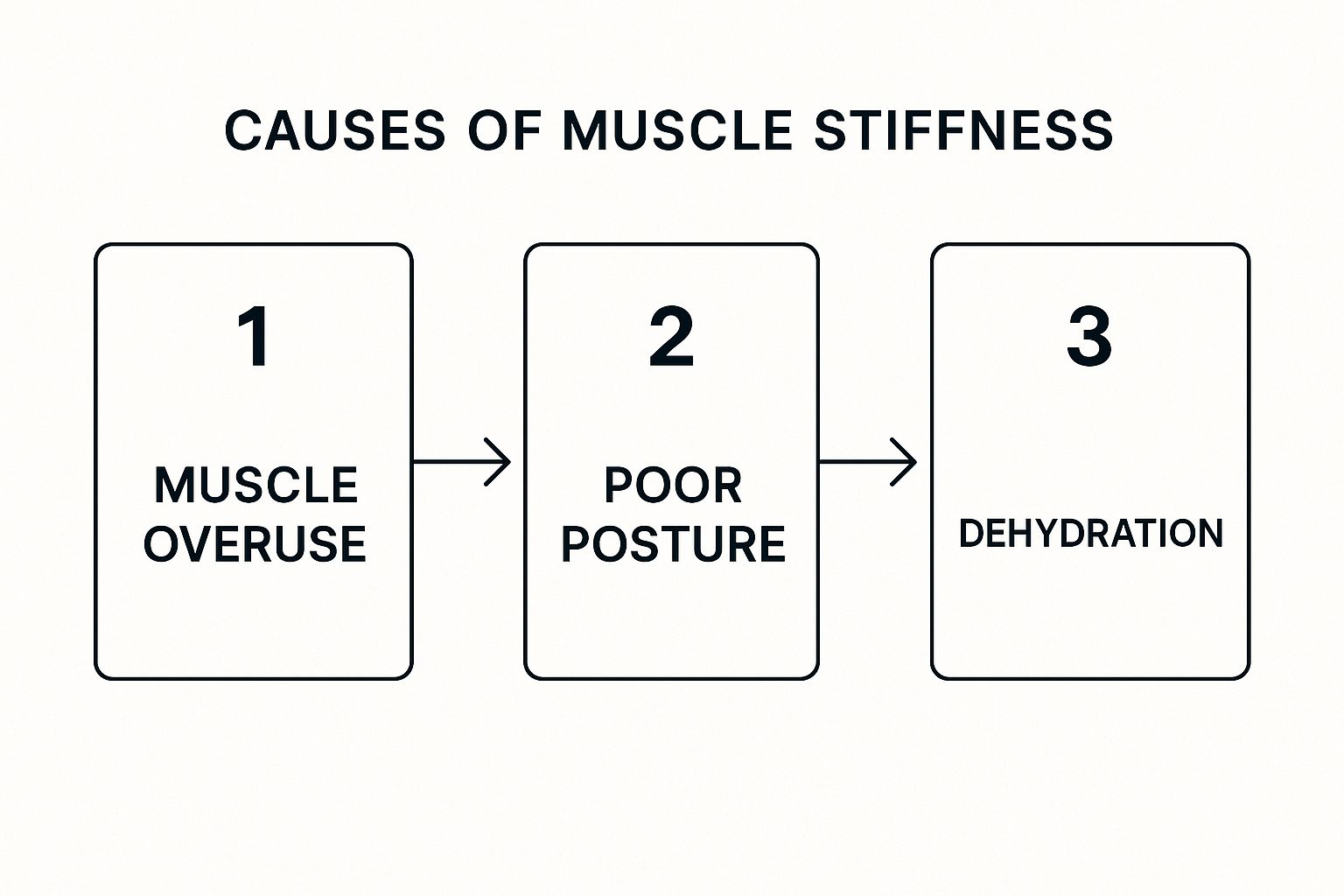
As you can see, things like poor posture and repetitive strain create a vicious cycle of tension. The good news is that a little self-massage is one of the best ways to break that cycle. For a deeper dive, our guide on https://blog.lamoondayspa.com/massage-for-neck-and-shoulder-pain/ has even more specific techniques you can try.
Making It a Consistent Habit
Turning these quick fixes into a regular habit is what delivers lasting change. Think about ways to build these moments into your day. Maybe you can even utilize shower body spray massage jets to work on tight muscles while you’re getting ready. The goal is to make self-care a seamless part of your routine, not another item on your to-do list.
It’s no surprise that so many people rely on massage for relief. In fact, studies show that its use for muscle and joint problems ranges from 2.2% to a staggering 81.2% across different parts of the world. North America, in particular, has one of the highest rates of use, which just goes to show how many of us have found it to be a trusted solution for stiffness and pain.
Targeting Leg and Hip Stiffness Like an Athlete
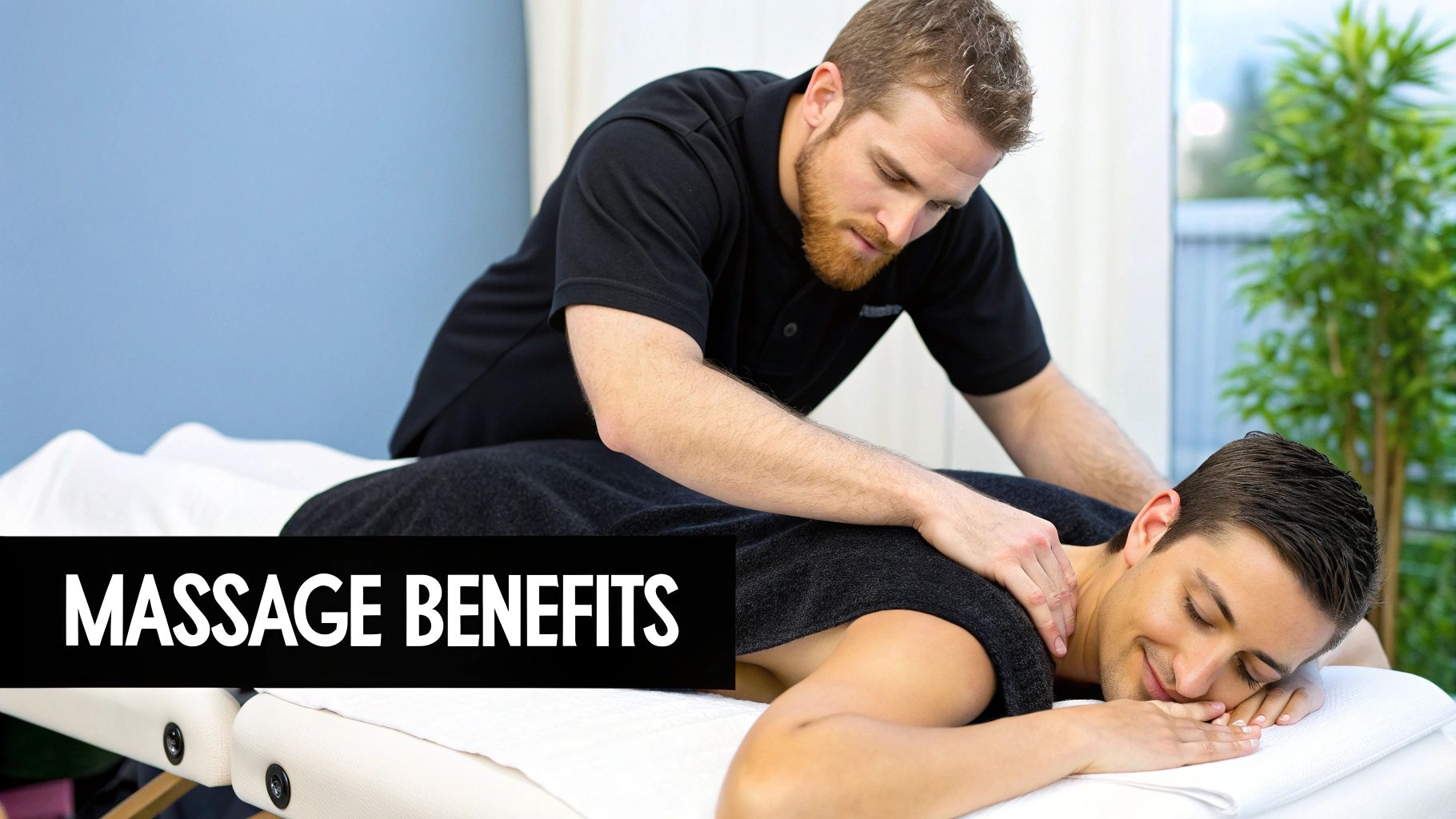
Your legs and hips are your body's engine, home to its largest and most powerful muscles. So, when they lock up—whether from a punishing workout or just a long day stuck in a chair—it can throw your whole body out of whack. This kind of stiffness calls for a more serious, targeted approach to massage.
From marathon runners to office workers, almost everyone has felt the misery of tight quads, hamstrings, or glutes. The fix usually involves more than a few basic stretches. You need techniques that can get deep into these dense muscles to really make a difference. It's all about applying the right kind of pressure to get rid of that soreness and restore your full range of motion.
Mastering the Foam Roller for Quads and IT Bands
There’s a good reason you see foam rollers in every gym. They’re fantastic for self-myofascial release—a technical term for breaking up the knots and adhesions in your muscles and the web of connective tissue, or fascia, that surrounds them. This is especially effective for big, broad muscles like your quadriceps.
To work on your quads, get into a plank position on your forearms with the roller under your thighs. Use your arms to slowly guide your body, rolling from just above your knees all the way up to your hip flexors. When you hit a spot that feels extra tender, stop. Just pause there for 20-30 seconds, breathe, and let the sustained pressure convince the muscle to let go.
Then there’s the IT band, that stubborn strip of tissue running along the outside of your thigh. The process is similar but often much more intense.
- Start by lying on your side with the foam roller positioned under your hip.
- Support your weight with your arms and your top leg, which gives you control over the intensity.
- Slowly roll down the outer side of your thigh, from your hip to just above your knee.
It’s going to be uncomfortable, no doubt about it. Go slow and focus on deep, steady breathing to work through it.
Quick, frantic rolling won't get you anywhere. The real magic happens with slow, deliberate pressure. Think of it like you're ironing out a stubborn wrinkle in a shirt—you need that slow, steady heat and pressure to smooth it out.
Releasing Deep Glute and Hip Tension
Sitting all day is a recipe for painfully tight glutes, which can sometimes lead to sciatica-like pain shooting down your leg. For this, a simple massage ball is your best tool. A lacrosse or even a tennis ball will do the trick.
Just sit on the floor, place the ball under one of your glutes, and gently roll around until you find a sore spot.
The goal here is sustained pressure. Once you've found a trigger point, lean your weight into it to deepen the massage. This direct approach can release knots that stretching alone simply can't touch. Runners, in particular, find this kind of targeted work incredibly beneficial. If you're looking for a more complete routine, our guide on https://blog.lamoondayspa.com/sports-massage-for-runners/ is a great resource to build upon this self-care.
While working on your legs and hips, don't forget that your feet are the foundation of it all. Problems there can easily travel up the chain. Incorporating some good foot stretches for flat feet can be a game-changer for your lower body's alignment and flexibility. It’s a holistic approach that tackles the root causes of stiffness, not just the symptoms.
So, you've decided to see a professional. Smart move. But walking into a spa and staring at a long menu of massage options can be overwhelming. It feels a bit like trying to order a coffee in a new city—they all sound promising, but which one is actually right for you?
Choosing the correct massage style is the single most important factor in getting real relief. It’s the difference between a pleasant, relaxing hour and a session that genuinely resolves your specific muscle stiffness.
The secret is matching the technique to what your body is telling you. If you’re just feeling generally wound up and tight from the daily grind, one style will be perfect. But if you have a gnarly knot in your shoulder that’s been bugging you for weeks, you’ll need a completely different approach.
Let's break down the most common types so you can book your next appointment like a pro.
Choosing the Right Professional Massage Style
For Overall Relaxation and General Tightness
If your main goal is to simply melt away stress and soothe muscles that are achy from everyday life, the classic Swedish massage is your best bet. Think of it as the gold standard for relaxation.
This style relies on long, flowing strokes (called effleurage), gentle kneading, and circular motions. The whole point is to calm your nervous system, ease surface-level tension, and get your blood flowing. It’s an excellent entry point if you're new to massage or just need to hit the reset button without the intensity of deeper work.
For Chronic Knots and Deep-Seated Tension
When you're dealing with that stubborn, deep ache in your lower back, a stiff neck that won't quit, or tight hamstrings, it's time to call in the heavy artillery: Deep Tissue massage. This technique goes way beyond the surface to work on the deeper layers of muscle and the connective tissue around them.
Your therapist will use slower, more deliberate strokes and apply focused, firm pressure to break up adhesions—those painful "knots" that mess with your mobility and cause chronic pain. It can be intense, for sure, but it should never be excruciating. A skilled therapist will always work with you to find a pressure that’s productive, not just painful.
Key takeaway: Don't mistake "deep tissue" for just "hard pressure." A proper deep tissue massage is strategic. It’s about targeting specific muscle fibers and fascia with precision, not just brute force.
Tailored for an Active Lifestyle
For athletes, gym regulars, or anyone with a physically demanding job, a Sports massage is built from the ground up to address your specific needs. This isn't a one-size-fits-all approach; it’s all about preventing and treating injuries, boosting flexibility, and keeping you at the top of your game.
A sports massage often blends different modalities—like stretching, deep tissue, and trigger point therapy—all focused on the muscle groups you rely on most.
You might book a sports massage for a few different reasons:
- Pre-event: A faster, lighter session to warm up the muscles and get you ready for action.
- Post-event: To help flush out lactic acid, reduce the dreaded delayed onset muscle soreness (DOMS), and kickstart recovery.
- Maintenance: Regular sessions to work out strain and imbalances before they sideline you with an injury.
Targeting the Connective Tissue
Sometimes, the root of your stiffness isn't just in the muscle belly itself. It’s in the intricate web of connective tissue that wraps around your muscles, called fascia. When this tissue gets tight and restricted, it can pull on everything, causing widespread pain and limited movement.
Myofascial Release is a specialized therapy that applies gentle, sustained pressure to these fascial restrictions. It doesn't feel like a typical massage; it's more like a slow, deep, targeted stretch. The goal is to gently coax the fascia to unwind and lengthen, giving the muscles underneath the freedom to move properly again. It's incredibly effective for pain that feels diffuse and achy rather than sharp and localized to one spot.
To make it even simpler, think of it this way: choosing a massage is about diagnosing your stiffness and picking the right tool for the job.
Matching the Massage Style to Your Stiffness
This table is a quick guide to help you select the most effective massage type based on what your body needs right now.
| Massage Style | Best For | Pressure Level | Key Technique |
|---|---|---|---|
| Swedish Massage | General relaxation, stress relief, mild tension | Light to Medium | Long, flowing strokes (effleurage), kneading |
| Deep Tissue Massage | Chronic pain, stubborn knots, deep muscle stiffness | Firm to Deep | Slow, deliberate strokes with focused pressure |
| Sports Massage | Injury prevention, enhancing athletic performance | Varies (Light to Deep) | A mix of stretching, deep tissue, and targeted work |
| Myofascial Release | Widespread stiffness, improving mobility, fascial restrictions | Gentle & Sustained | Slow, sustained pressure to stretch connective tissue |
Ultimately, the best massage for you is the one that addresses your specific symptoms. Don't be afraid to talk to your therapist beforehand about what you’re feeling—a good professional will help guide you to the perfect session.
Knowing When to See a Professional
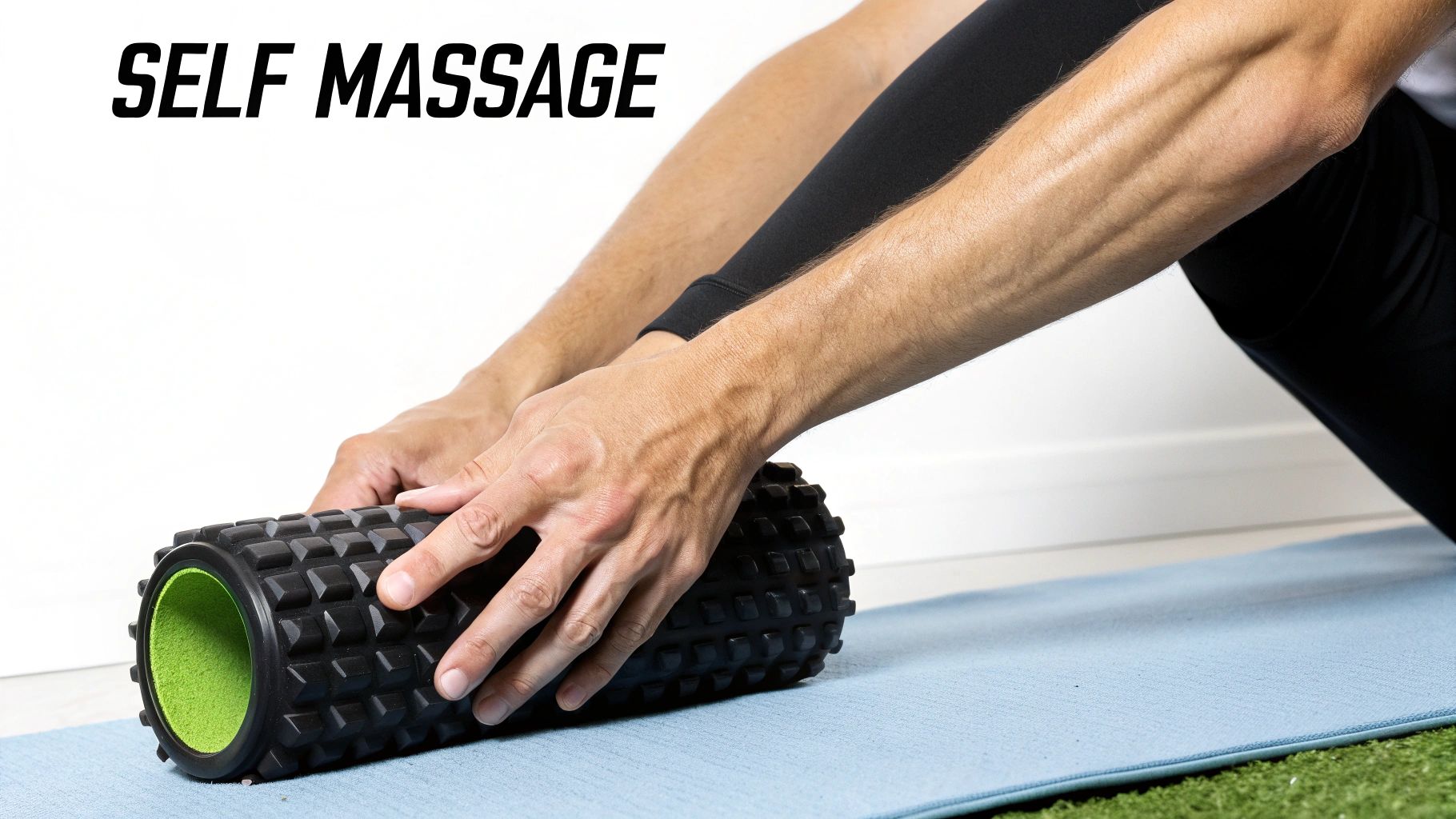
While self-massage gives you incredible control over your day-to-day muscle care, it’s just as important to know its limits. Think of it as first aid for muscle stiffness—perfect for general soreness and minor knots. But it's not a replacement for a professional diagnosis when something more serious might be going on.
Understanding the difference is key to staying safe and getting the right treatment. Your body is pretty good at telling you when a problem is beyond a DIY fix. Learning to listen to those signals is a skill, just as valuable as mastering any massage technique. It’s all about being smart with your recovery.
Red Flags That Signal a Professional Visit
So, when should you put down the foam roller and pick up the phone? Certain symptoms are more than just typical muscle stiffness; they're your body's way of saying, "Hey, I need an expert opinion on this."
Keep an eye out for these red flags:
- Sharp, Shooting, or Radiating Pain: A dull ache is one thing, but a sharp pain that zips down an arm or leg could point to nerve involvement.
- Numbness or Tingling: That persistent "pins and needles" feeling or a loss of sensation isn't something to ignore. It’s a clear sign to see a doctor.
- Stiffness That Gets Worse or Won't Quit: If you’ve been diligently working on an area for a week with no improvement—or if the pain is actually increasing—it’s time for a professional to take a look.
- Visible Swelling or Bruising Without an Obvious Cause: Unexplained swelling or discoloration around a stiff muscle might be a sign of something more than just a simple knot.
The goal here isn’t to cause alarm, but to empower you. Recognizing these signs helps you avoid making a problem worse. It ensures you’re addressing the root cause, not just putting a band-aid on the symptoms.
The Proven Power of Professional Care
When you see a qualified professional, you’re getting a level of care that can deliver some pretty significant results. Their expertise goes far beyond just rubbing a sore spot; they have a deep understanding of how your body's systems all work together.
The science backs this up, too. A comprehensive analysis of multiple studies confirmed just how effective professional massage is. It found that massage significantly reduced muscle soreness at 24 hours, 48 hours, and even 72 hours after a session. It didn’t just make people feel better—it also measurably improved their muscle function. You can dive into the full study about massage and muscle recovery to see the data for yourself.
This shows that getting a professional massage for muscle stiffness is a powerful move for both pain relief and real, functional recovery. It helps get you back to feeling and performing your best, safely and effectively.
Got Questions About Massage and Stiffness? We’ve Got Answers.
As you start exploring massage to ease muscle stiffness, you're bound to have some questions. It’s totally normal. Getting the right information is the key to feeling confident and making sure you’re getting the most out of every session, whether you’re at home or with a pro. Let’s dive into some of the things people ask me all the time.
How Often Should I Be Doing This?
This is easily the number one question I get. The honest answer? It really depends on your body, your lifestyle, and what you’re trying to achieve. While there’s no magic number, I can give you some solid guidelines based on my experience.
For your at-home toolkit—think foam rollers and massage balls—a good rhythm for general upkeep is 3 to 5 times a week. If you’ve just crushed a hard workout or a long run, don't be afraid to use them daily for a few days to speed up recovery. Just keep the sessions brief and to the point, maybe 10-15 minutes targeting the big, overworked muscle groups.
Now, for professional massage, it's a different ballgame that often comes down to your specific needs and, let's be real, your budget.
- Tackling Chronic Issues: If you're dealing with stubborn, long-term stiffness, getting on the table every 1-2 weeks can be a game-changer. This frequency really helps break the cycle of tension.
- General Wellness and Prevention: If you're looking to stay loose and keep stress from building up, a monthly massage is a fantastic routine. It’s like a regular tune-up for your body.
Is It Normal to Be Sore After a Deep Tissue Massage?
Yes, absolutely. A little soreness the day after a deep tissue or sports massage is completely normal. We often call it post-massage soreness, and it feels a lot like the ache you get after a good, challenging workout.
Think of it this way: your therapist is manually breaking up adhesions and tight knots that have been stuck deep in your muscles for a while. This process intentionally creates a small, controlled inflammatory response, which is actually the first step in your body's healing process. This feeling usually fades within 24 to 48 hours.
Here's the crucial part: you need to know the difference between "good sore" and "bad pain." A dull, tender ache in the muscles that were worked on is fine. Sharp, stabbing, or radiating pain is not.
To help yourself feel better faster, make sure you drink plenty of water after your appointment. This helps flush out all the metabolic byproducts released from your muscles. A gentle walk or some light stretching can also do wonders to keep things from tightening back up.
Could a Massage Actually Make My Stiffness Worse?
It’s rare, but yes, in certain situations, a massage can backfire. The biggest mistake I see is someone applying intense, deep pressure directly on an acute injury or a highly inflamed area. If you just pulled a muscle, for example, digging into it with a deep tissue massage can cause more damage and set your recovery back.
Using the wrong approach can also be a problem. A light, relaxing Swedish massage probably won't touch those deep, chronic knots, leaving you feeling like nothing happened. On the flip side, getting an aggressive sports massage when all you wanted was to de-stress might just leave you feeling beat up and more tense than when you walked in.
The takeaway is simple: listen to your body and talk to your therapist. A good professional knows when to back off and how to tailor the pressure. If you're doing self-massage, always start gently and immediately stop anything that causes sharp pain.
Ready to experience how a professional, targeted massage can help you? The expert therapists at La Moon Massage and Facial in Houston are here to help you relieve stiffness, reduce pain, and get your body back in balance. Book your session today and feel the difference for yourself.
